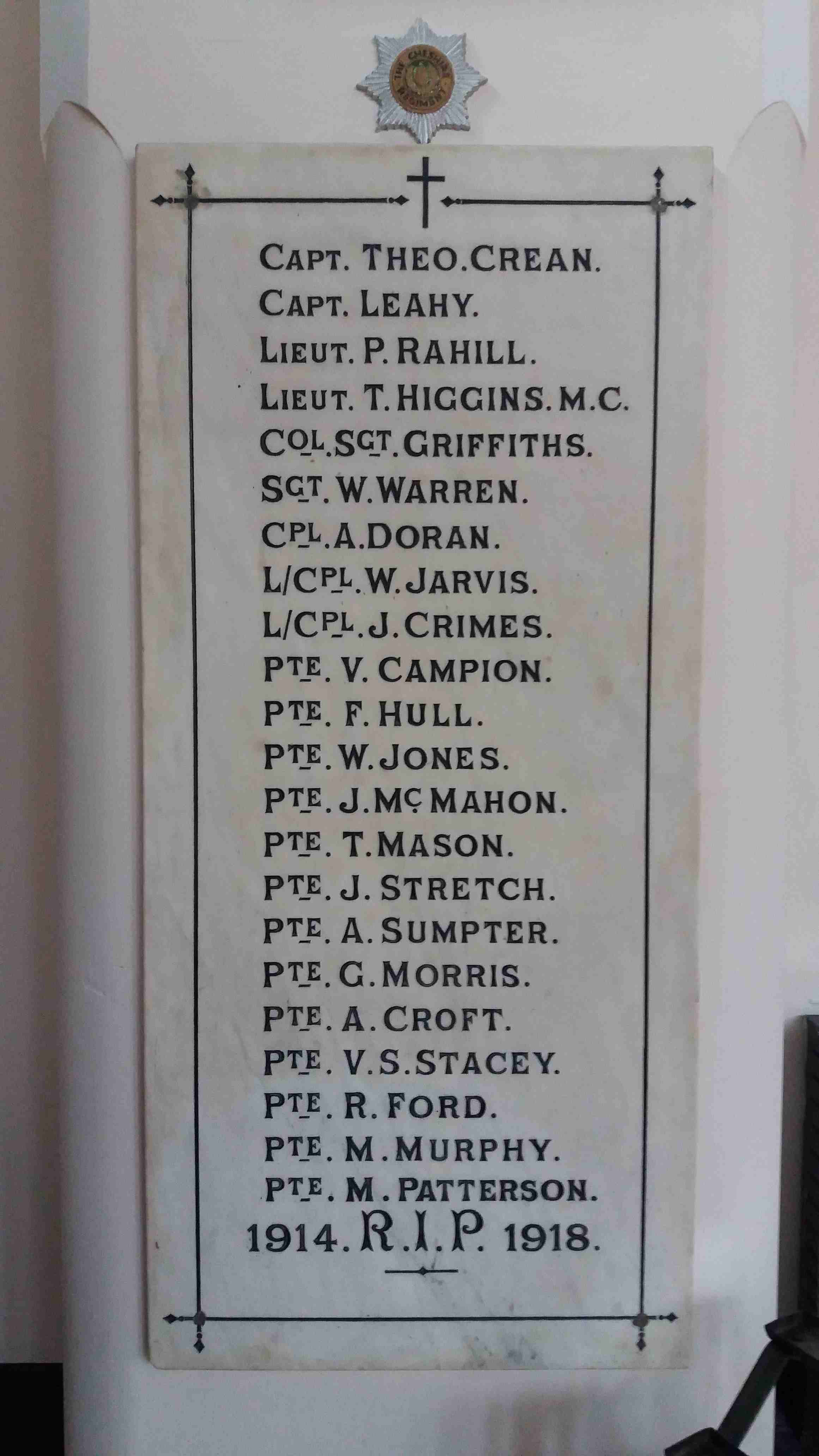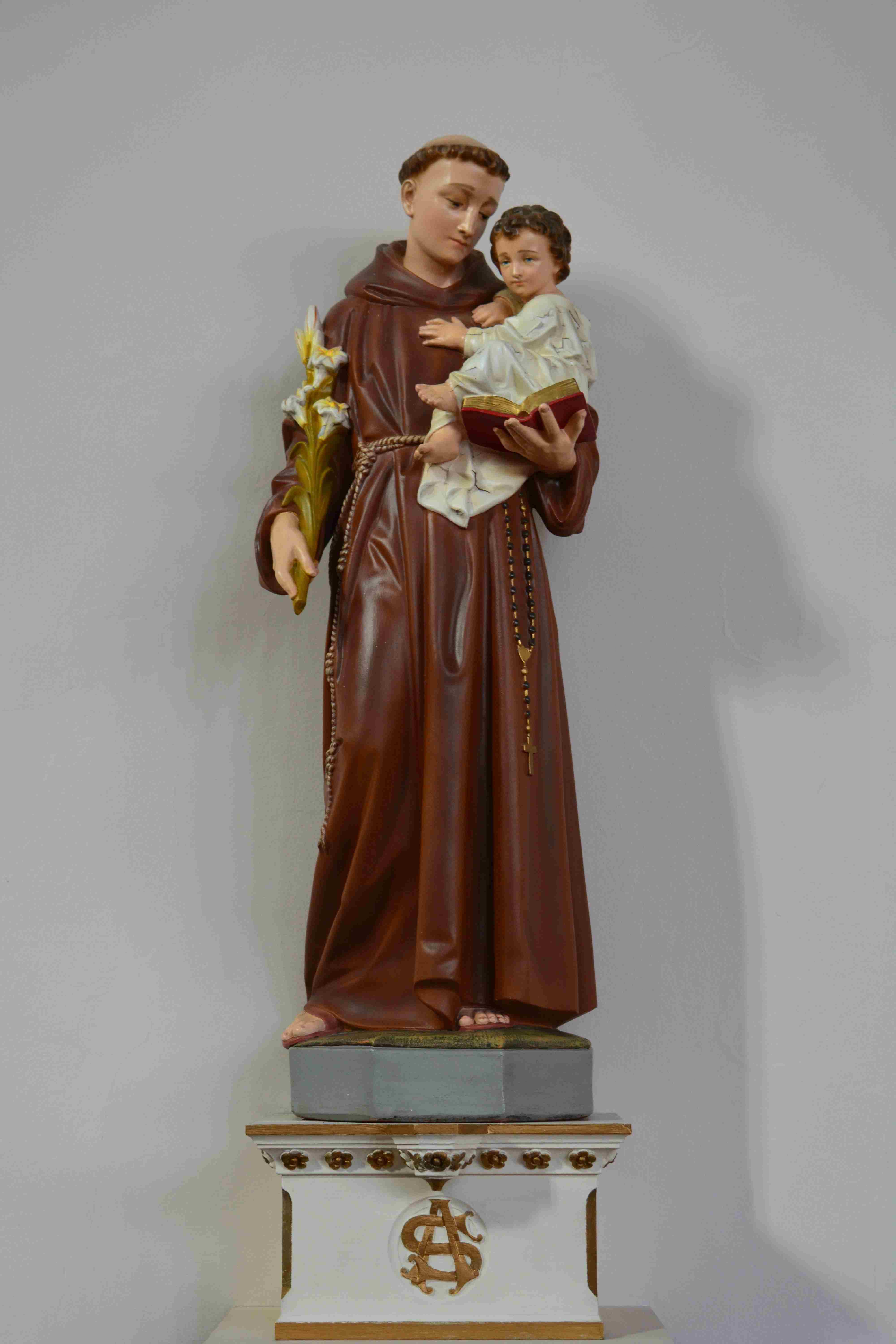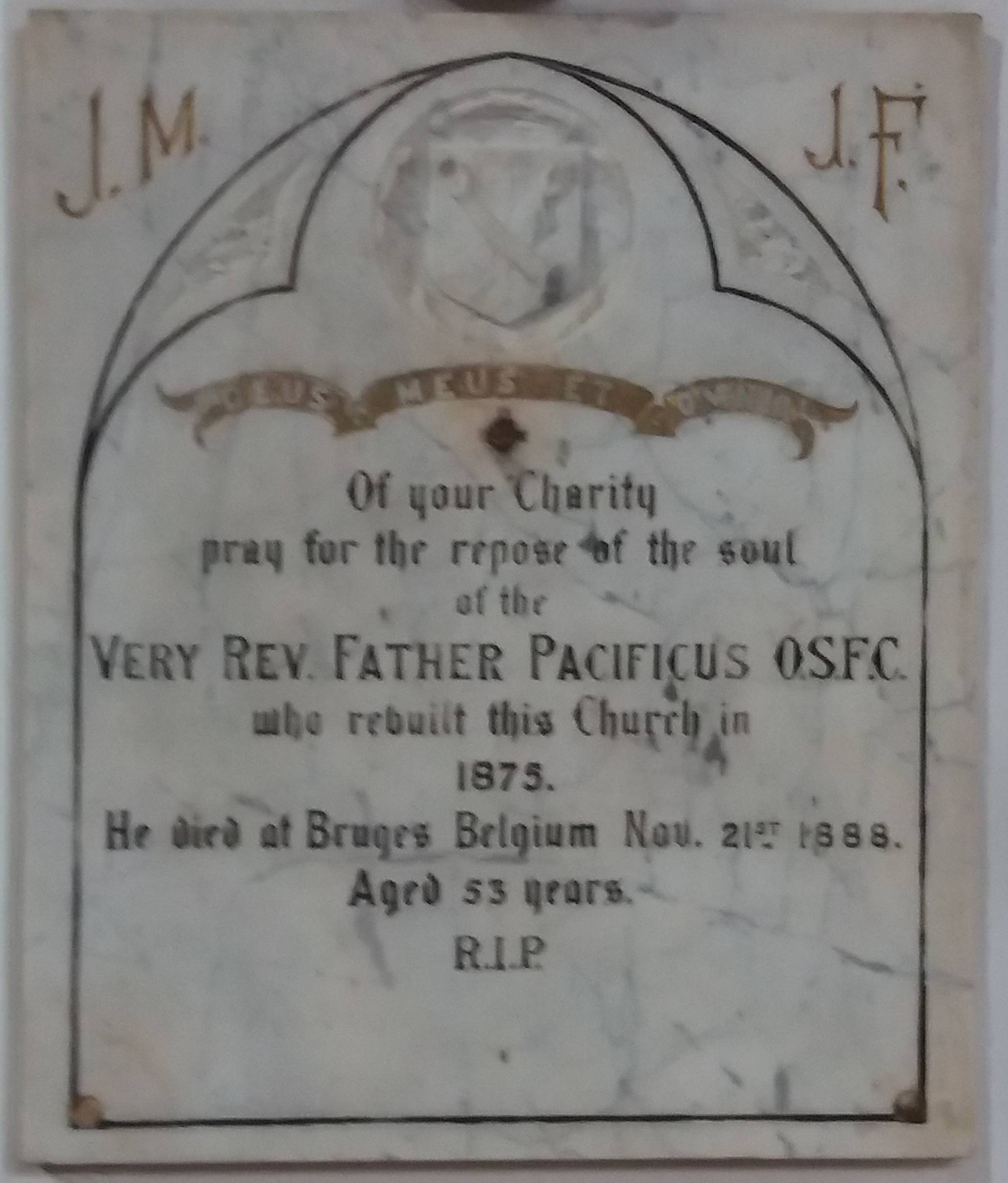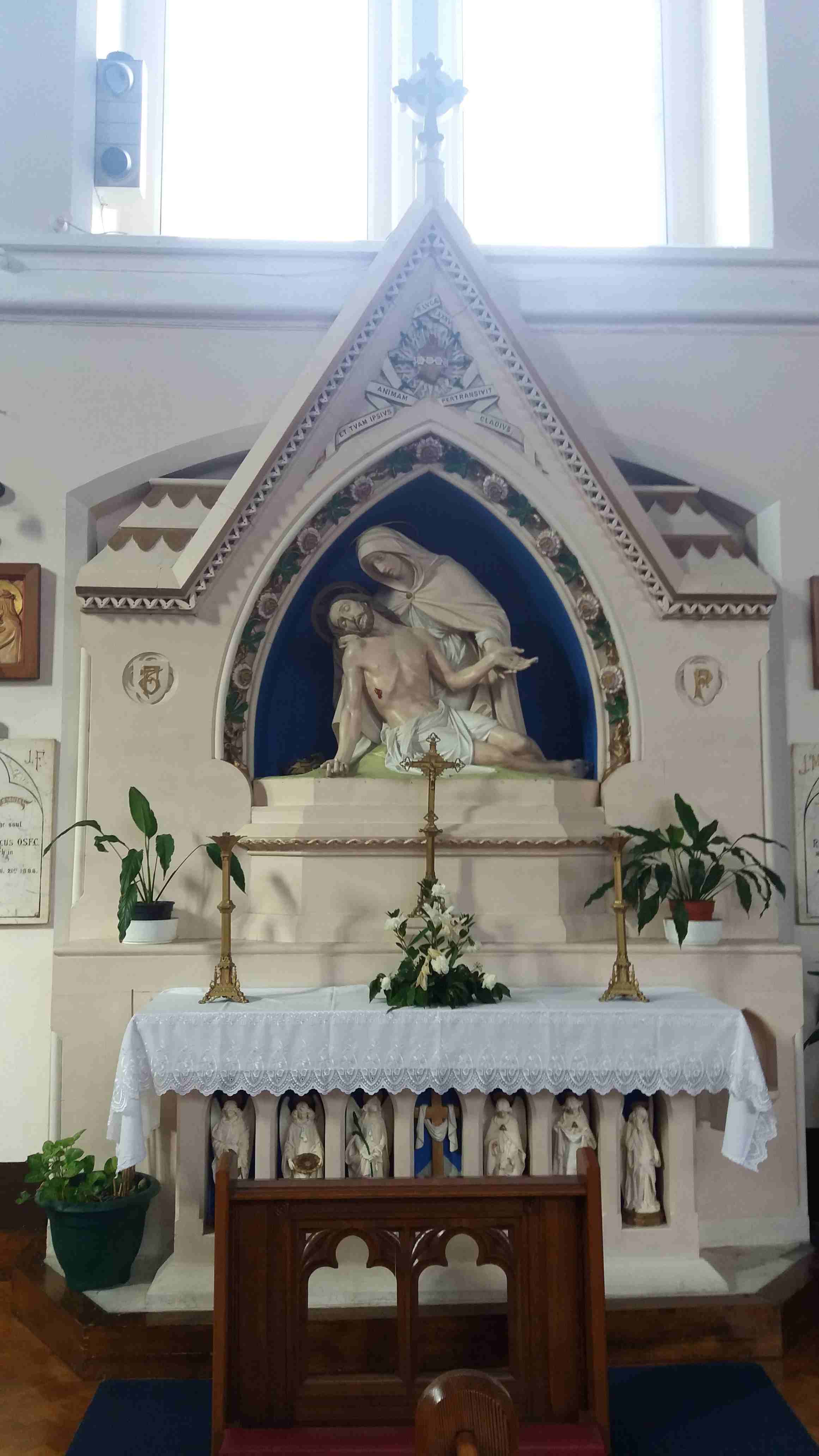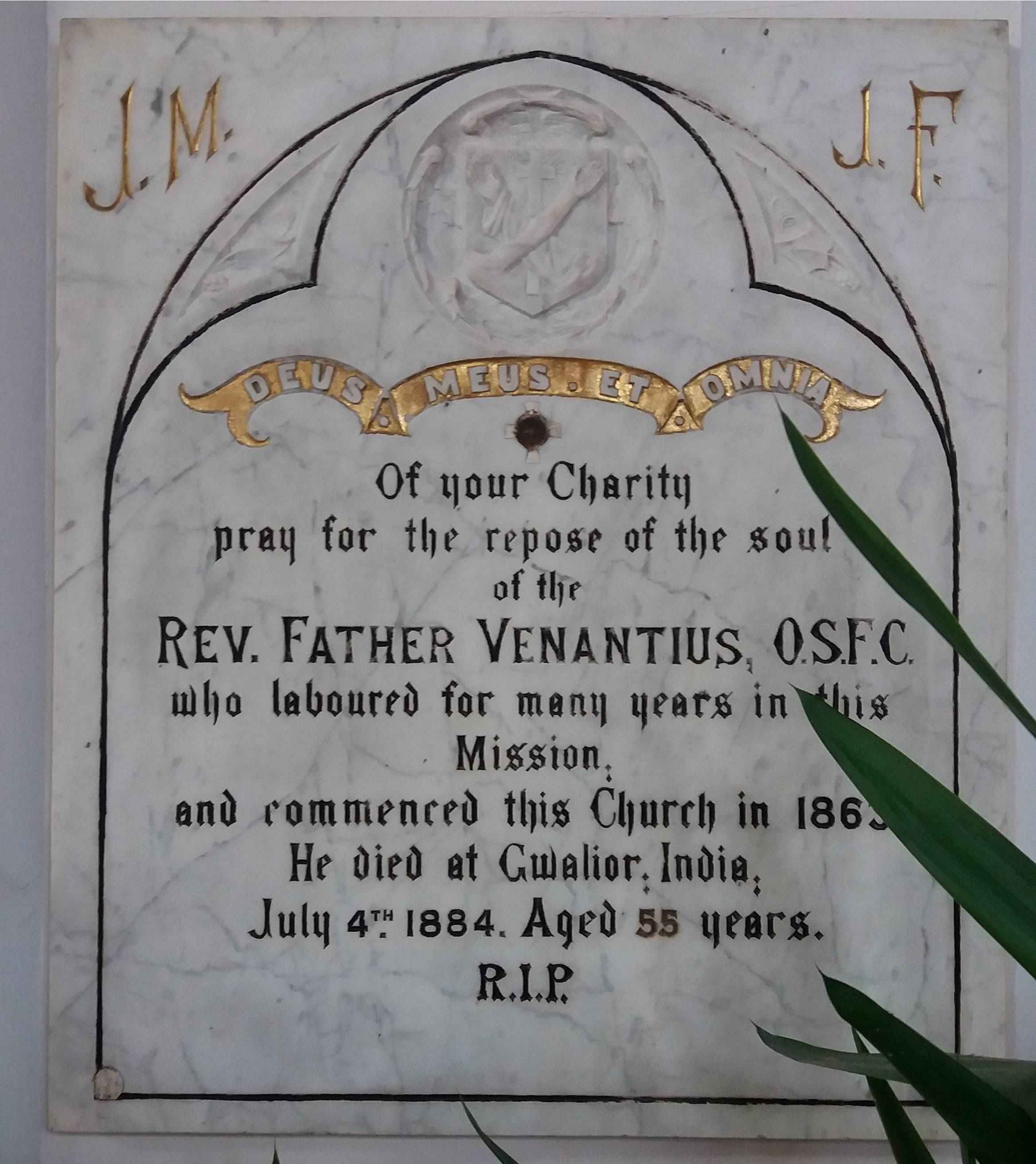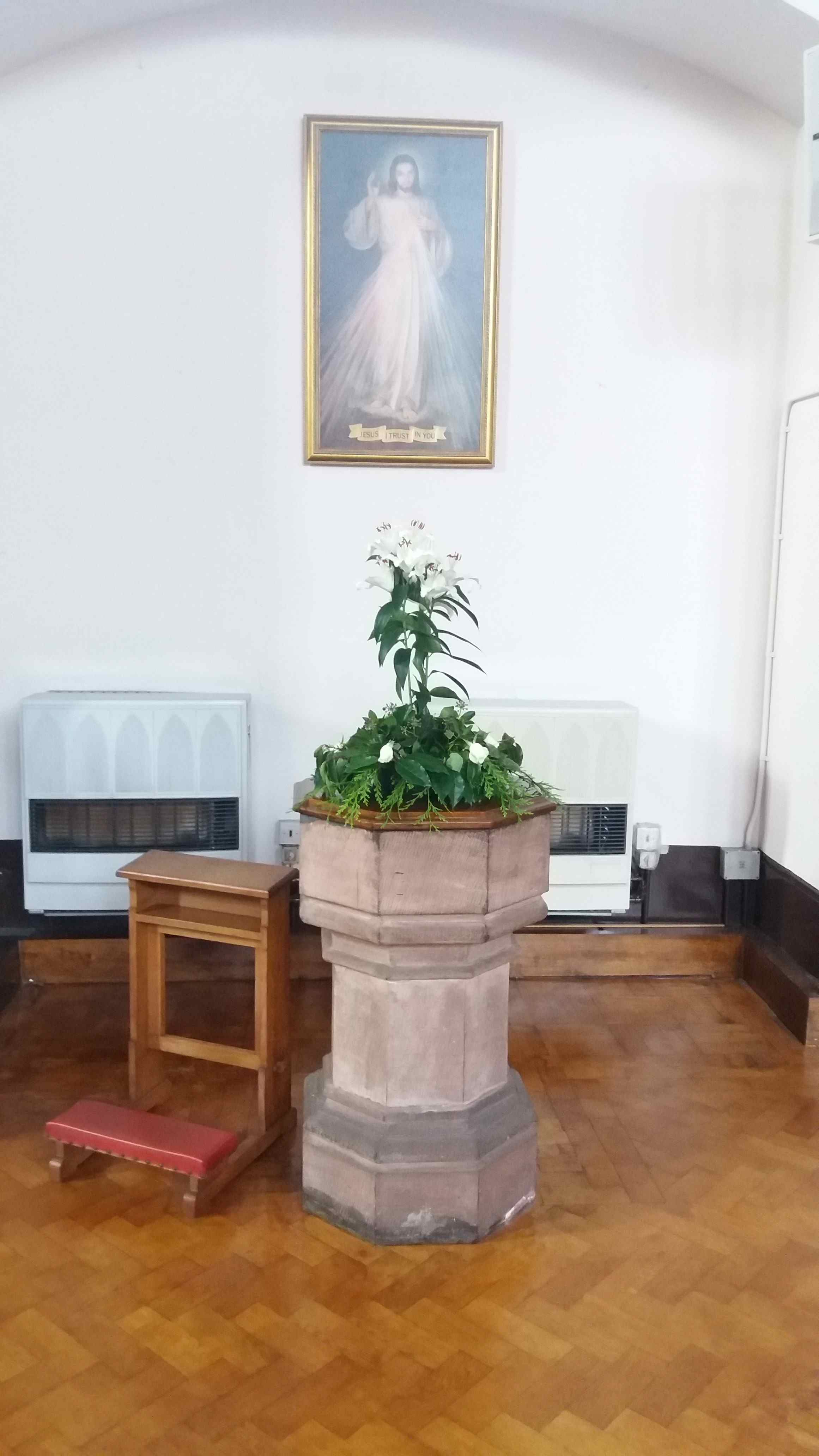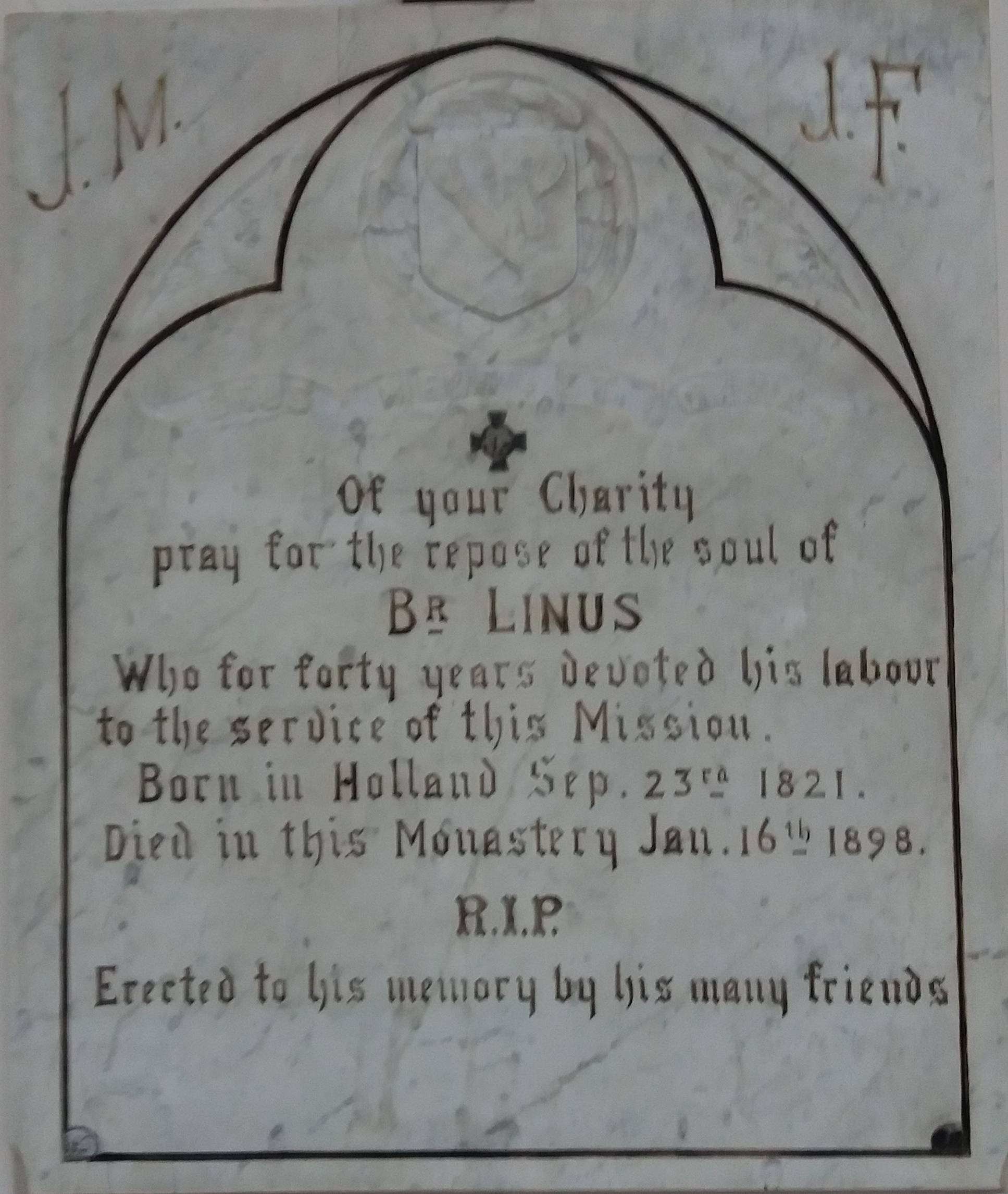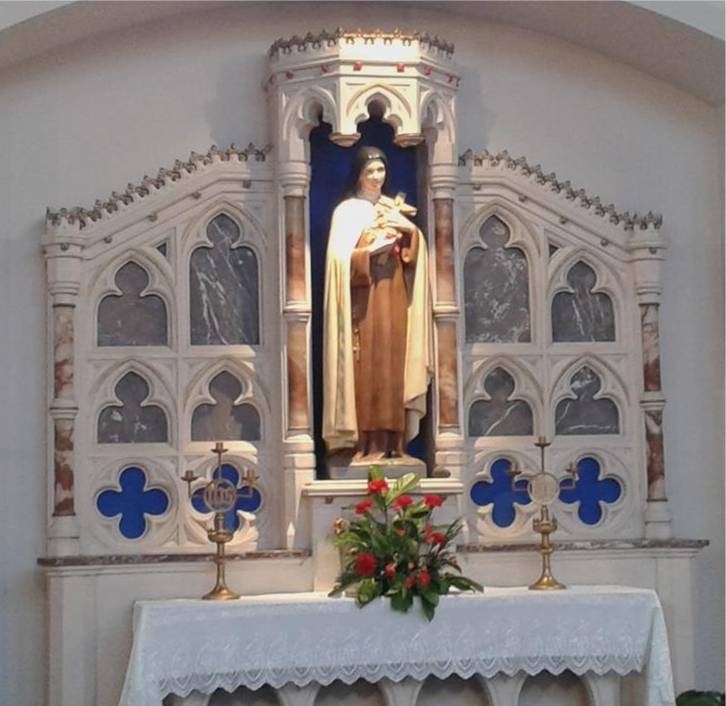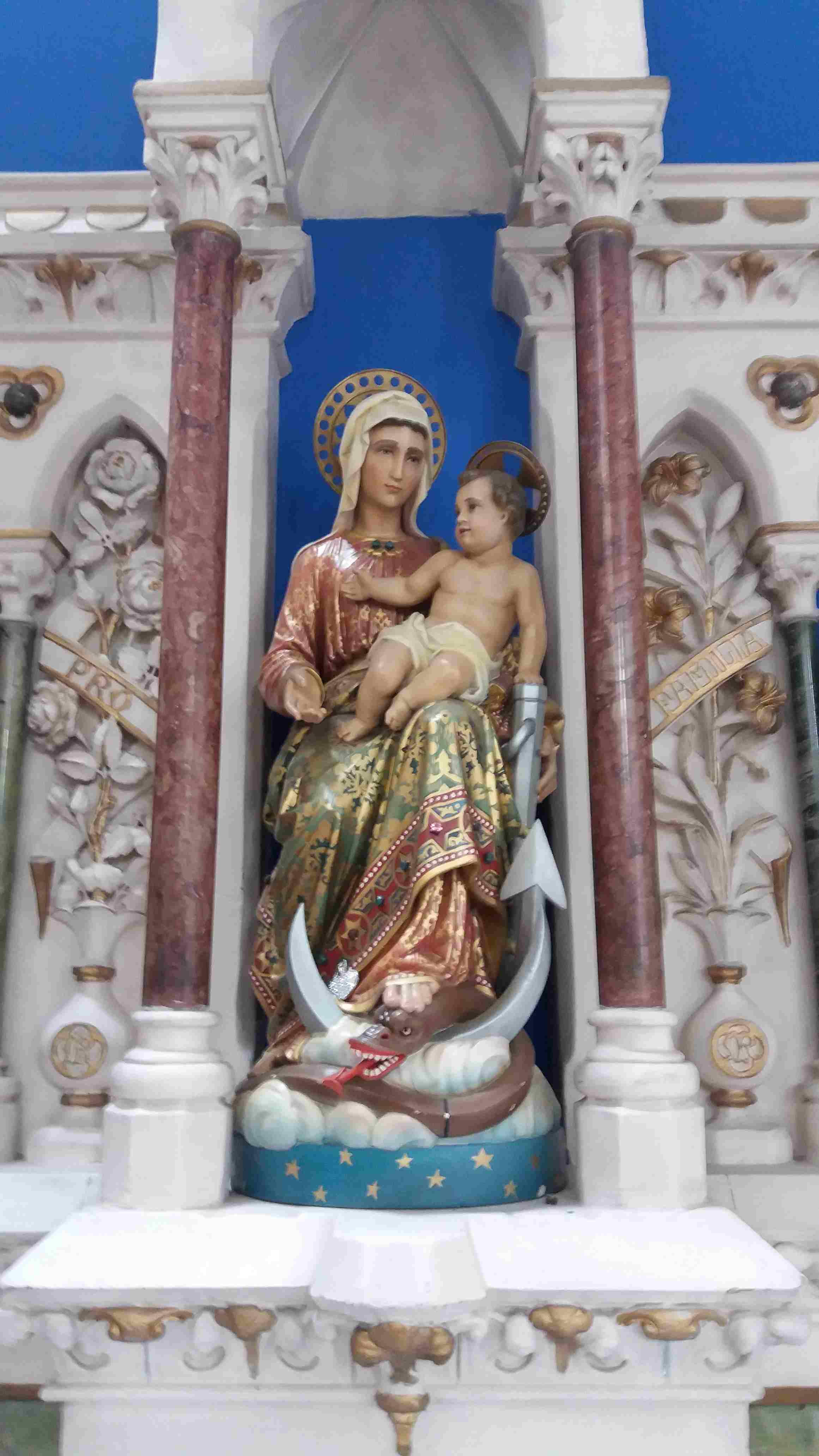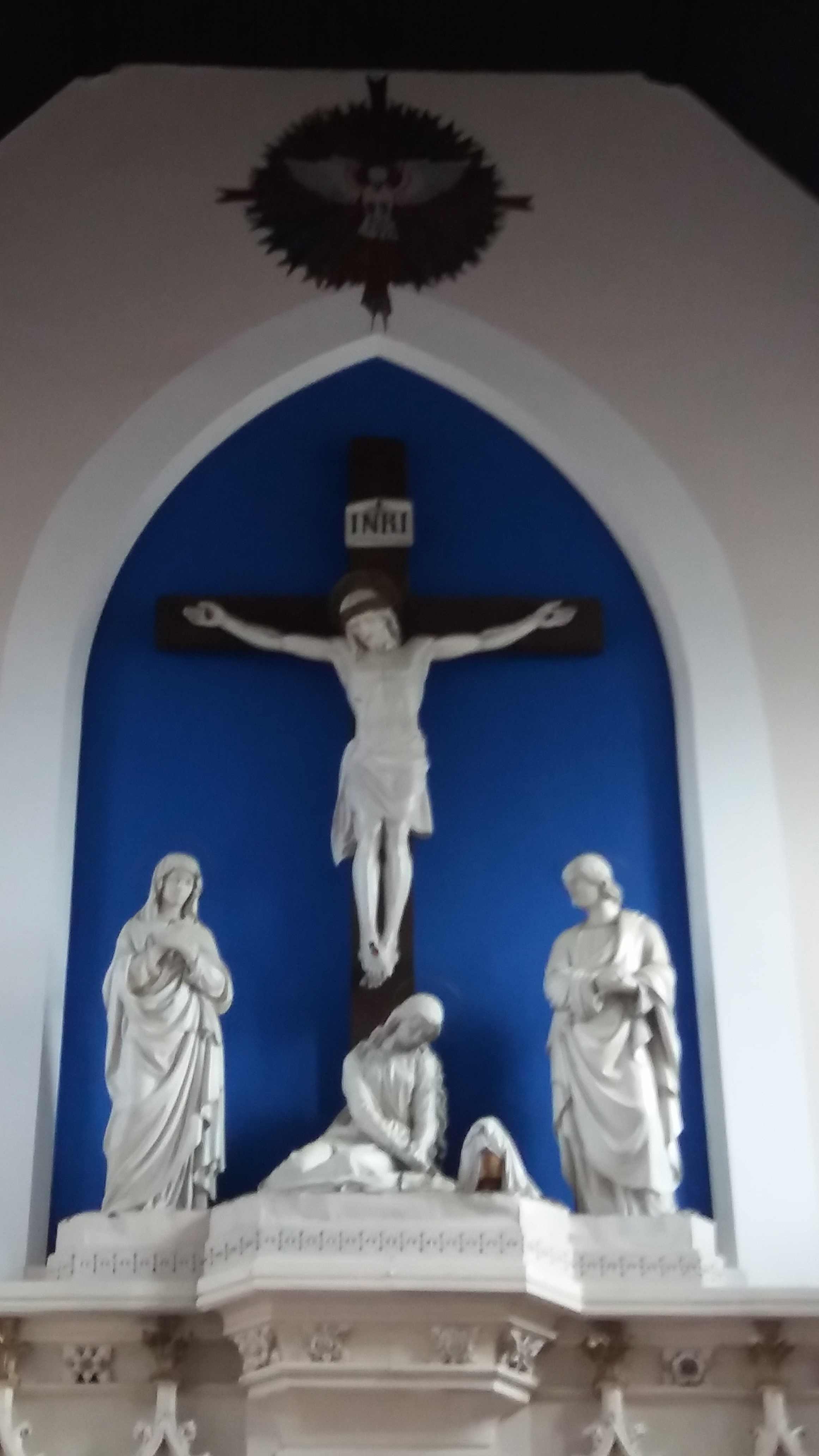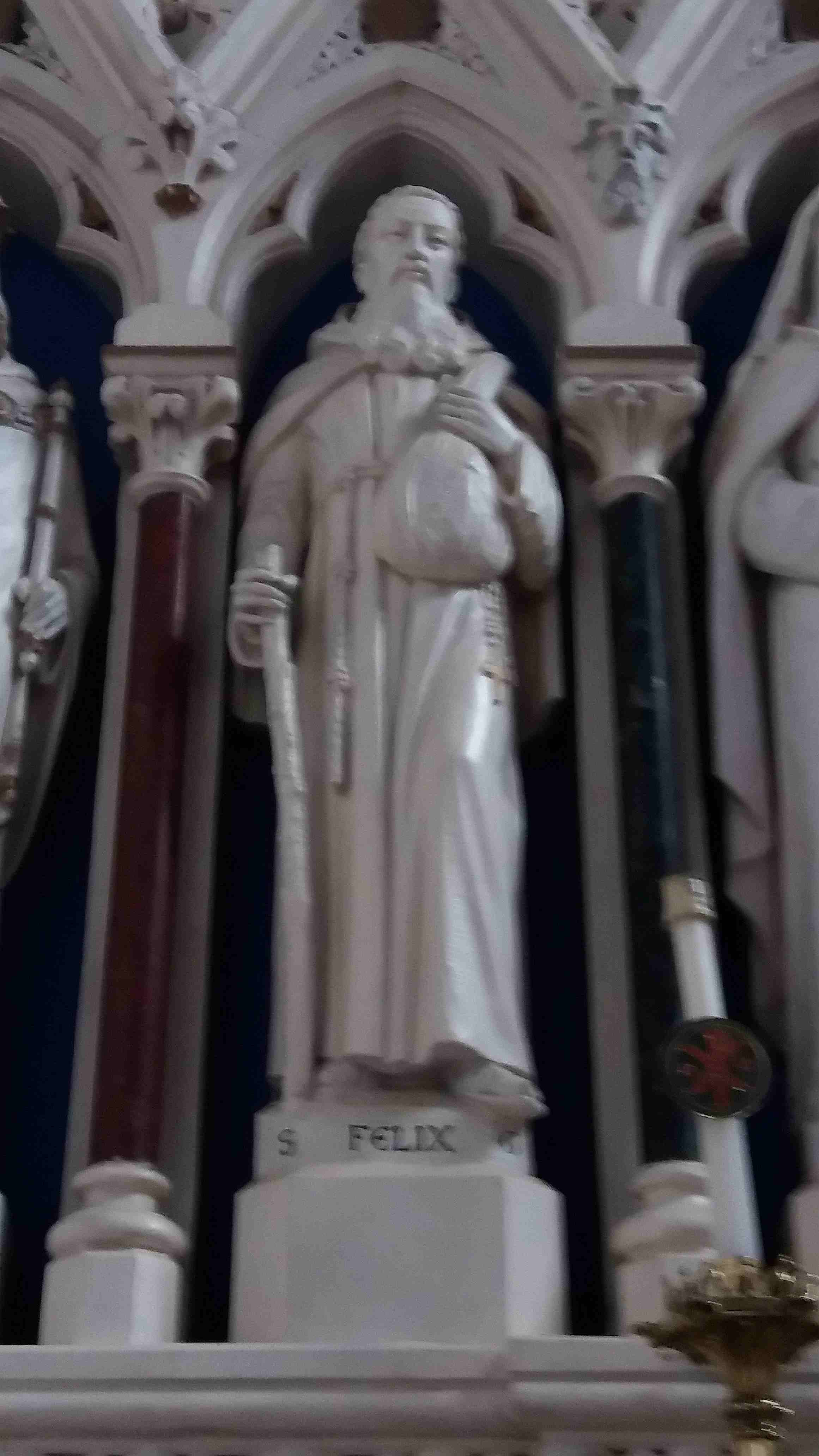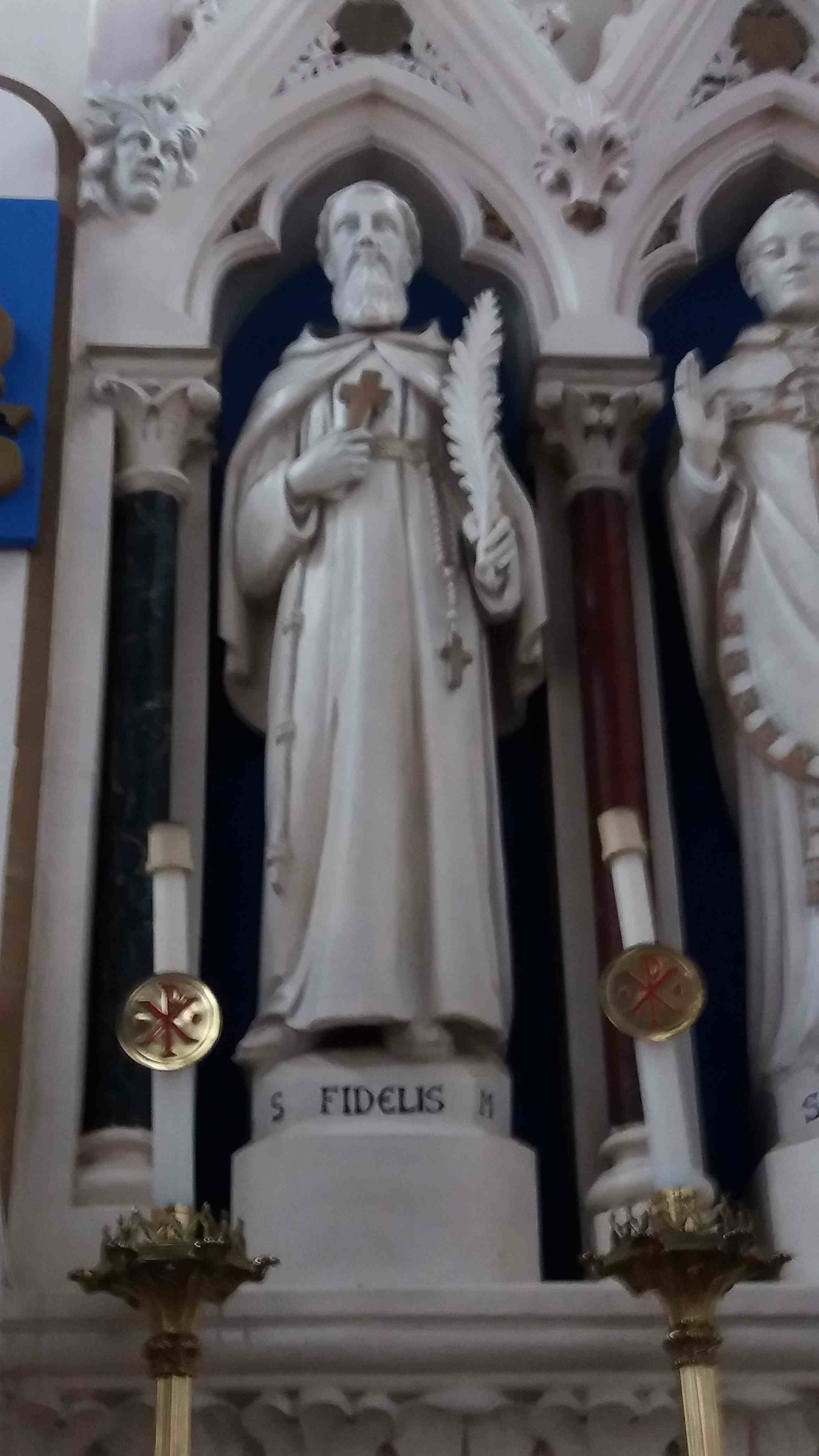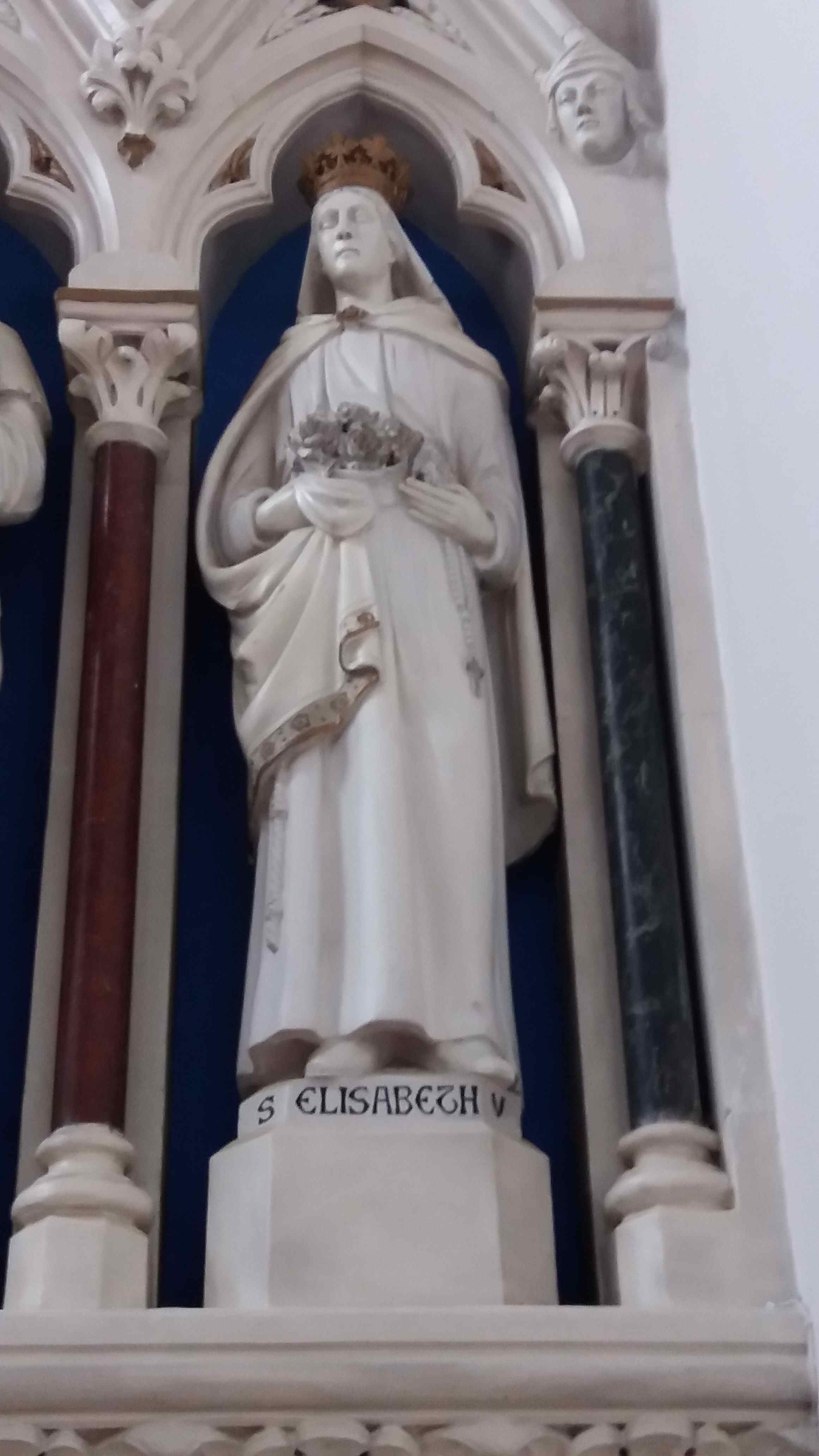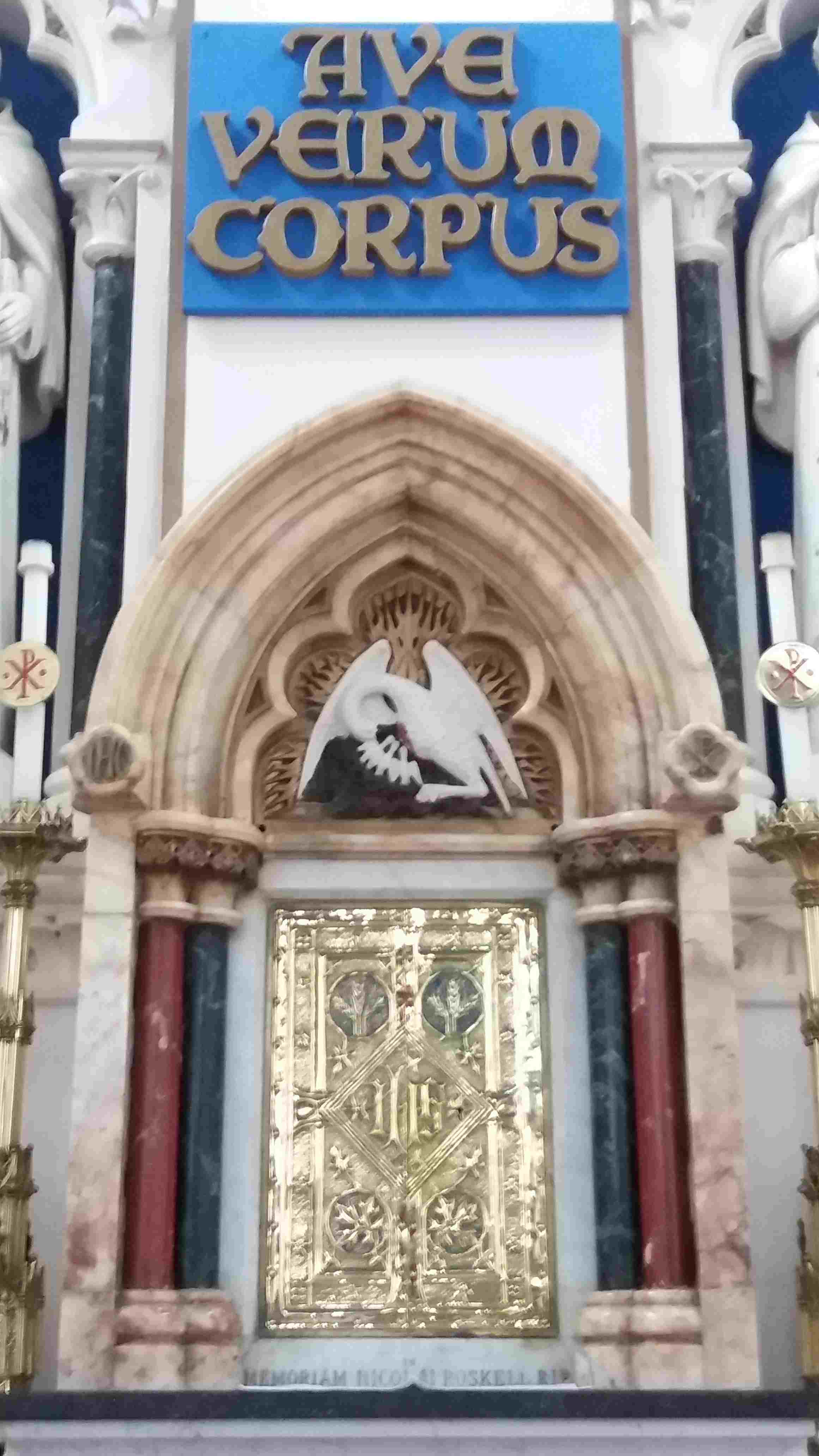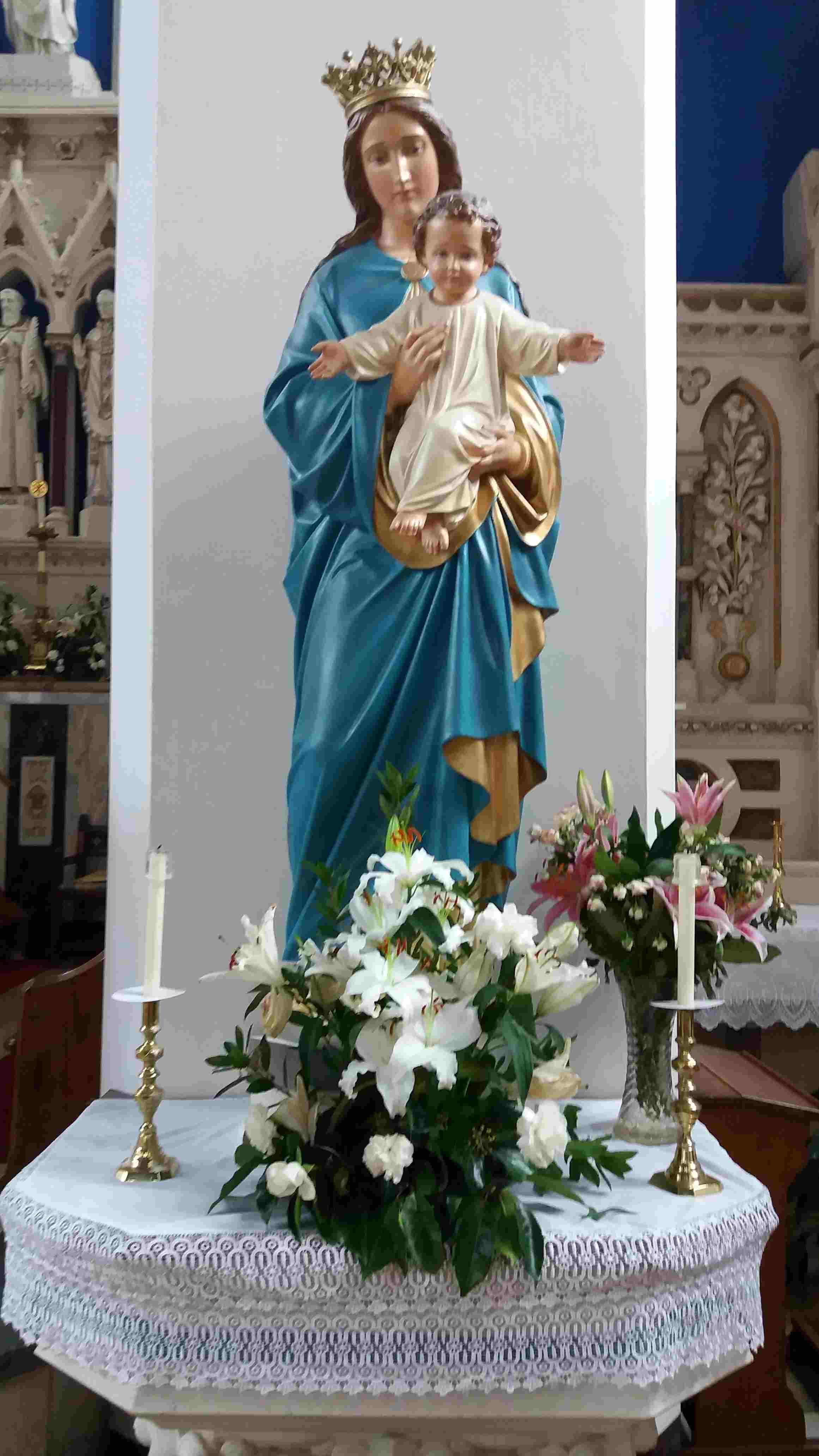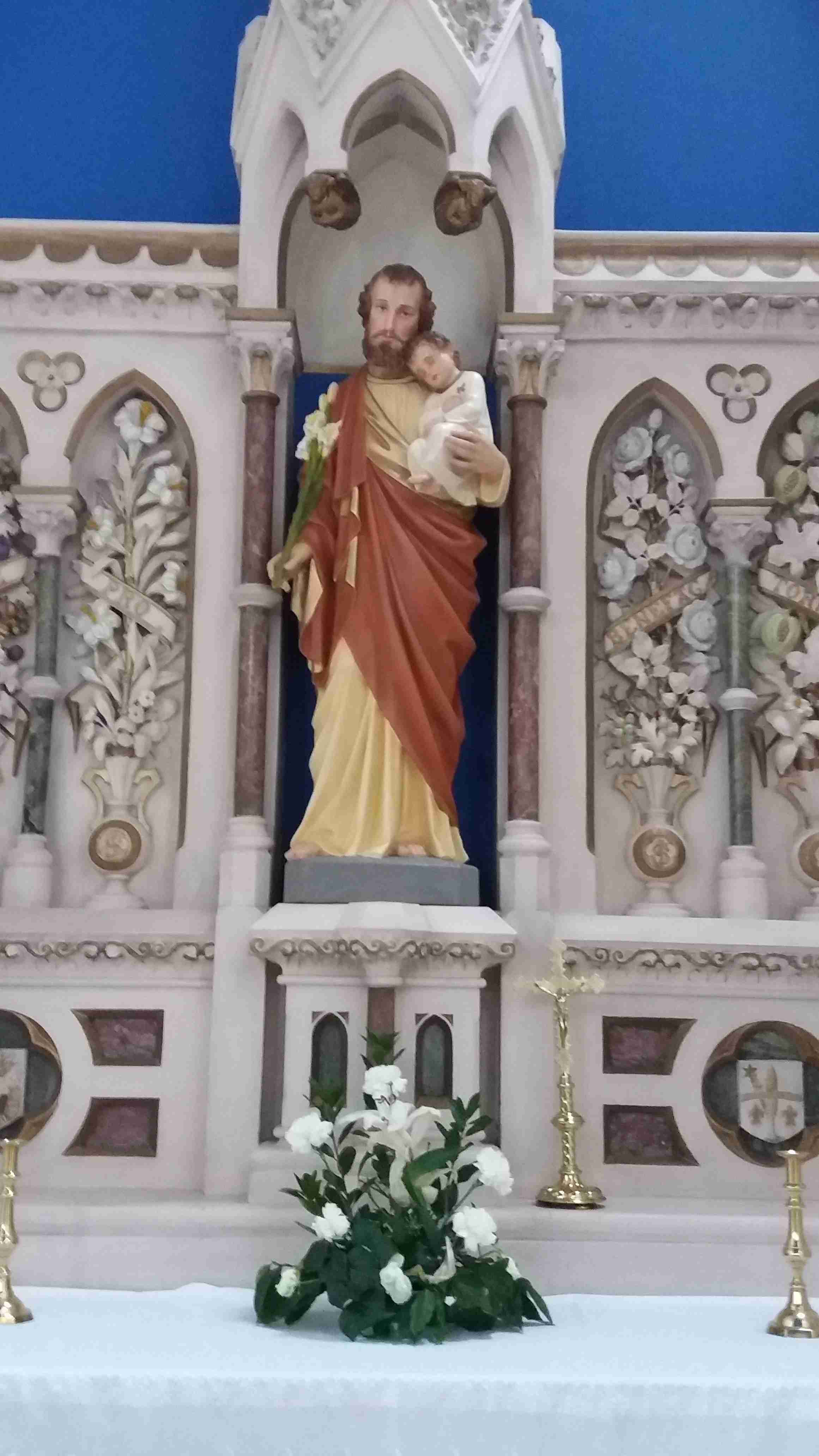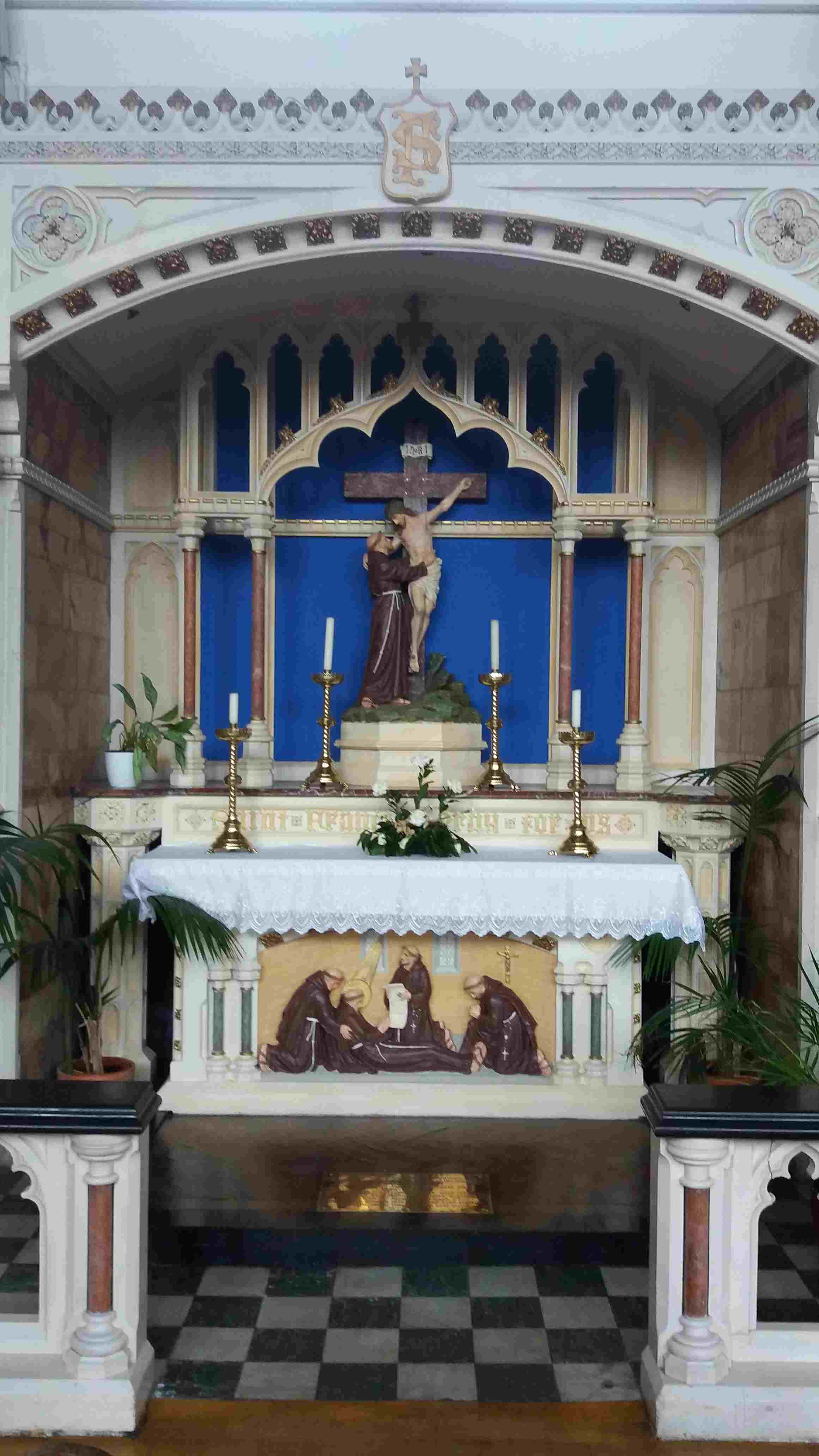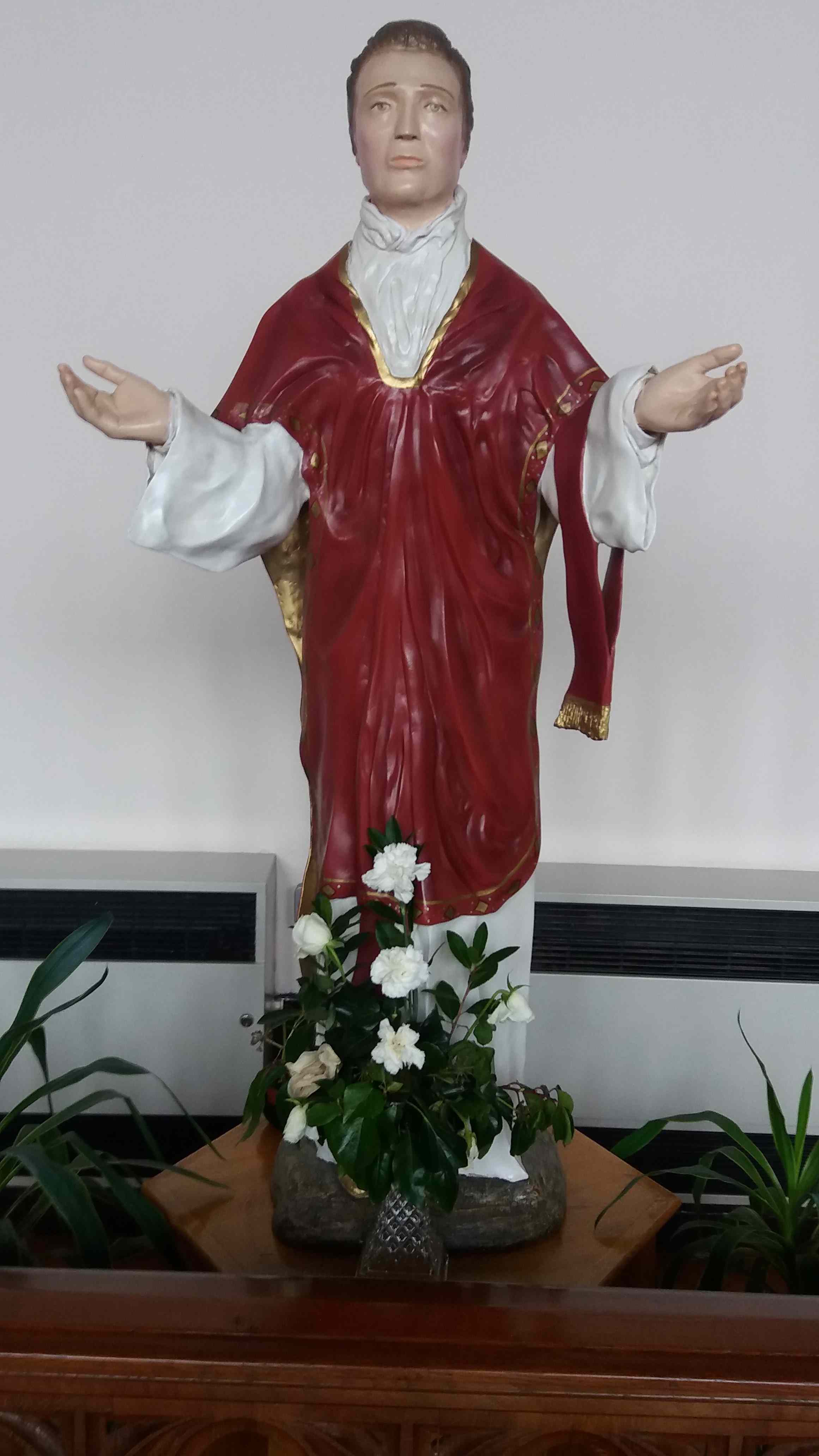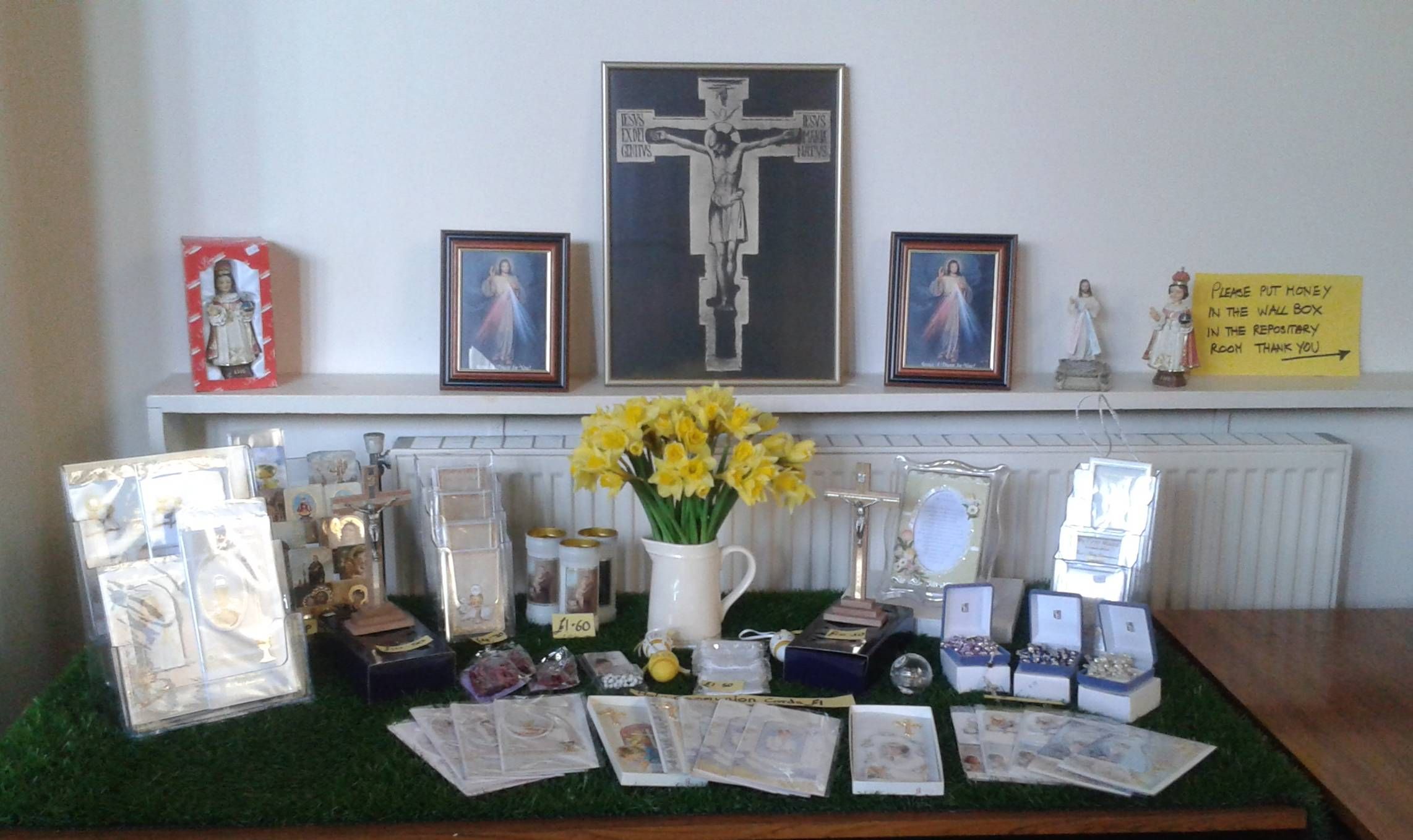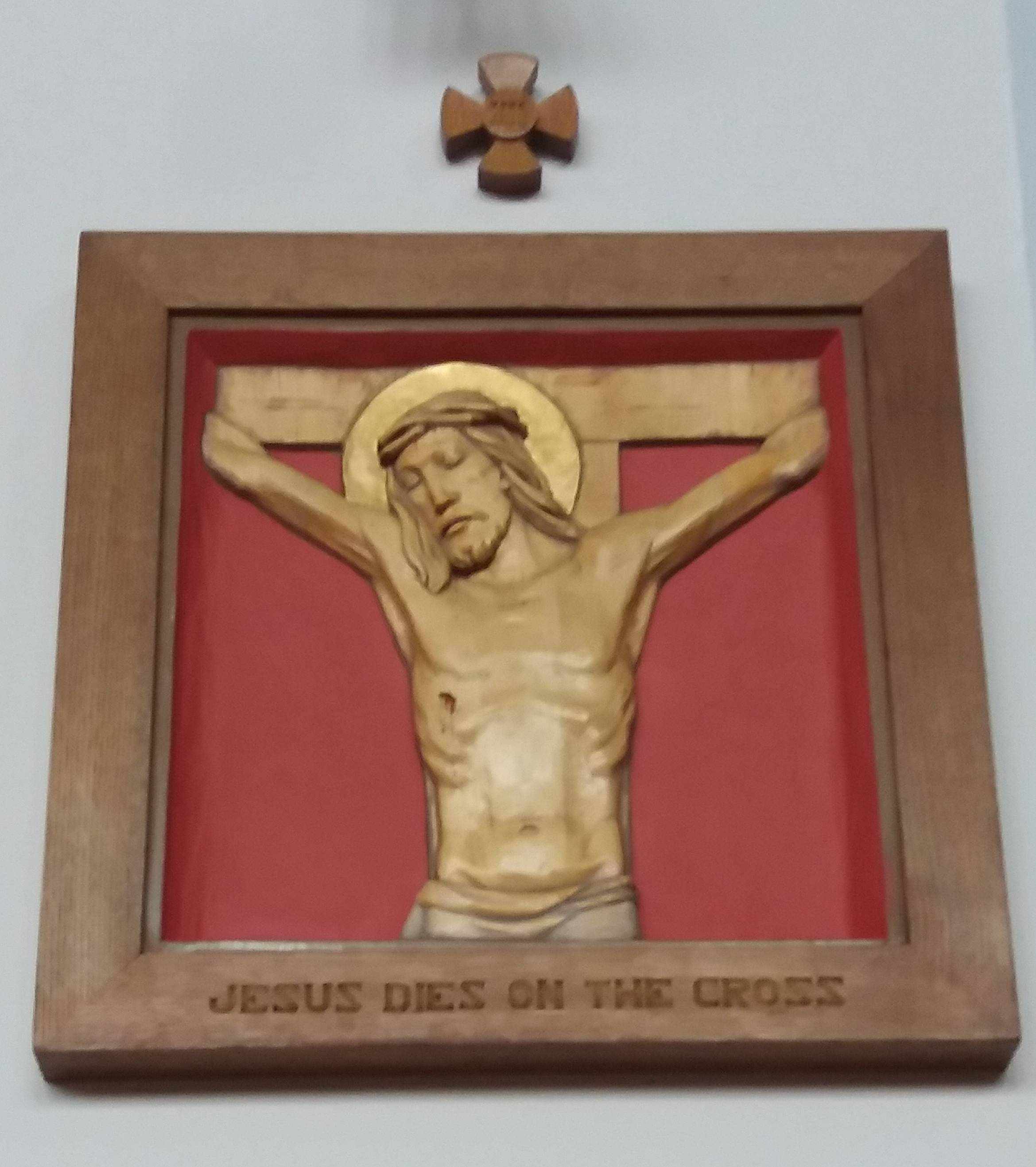St Francis of Assisi
Roman Catholic Church, Grosvenor Street, Chester, CH1 2BN, UK
A Guided Tour of St Francis Church, Chester
This tour is the first part of a book called 'Franciscans In Chester: St Francis' Church and Friary' written by Peter Bamford and Bernard Beatty. The book will be digitally published on the St Francis Church website in sections during 2017. Click on the 'History' tab.
By clicking on the thumbnail pictures on the tour they will open full size in a new tab on your browser.
Here is a free, five page, printer friendly pdf of the tour which can be downloaded or printed out before visiting our church.
[St Francis Church Tour - PDF Guide]
The Tour
1. St Francis Church
The building was designed by James O'Byrne, an architect practising in Liverpool and opened on 29 April 1875. Pevsner's Buildings of England series describes it as "a surprising building, wide and aisleless, without a tower. The treatment of the upper windows inside is very original." James O'Byrne gave the statue of St Francis which stands above the main entrance to the church.
2. The Church Porch
It is best to start off in the porch, whose glazing allows a good general view of the church interior, and to proceed clockwise. The panels on either side of the porch, in English and Latin, contain a brief account of the early days of the Capuchin mission and the opening of the church. The coat of arms above the left-hand panel on either side is that of Pope Pius IX (1846-1878), who was pope when the church was opened, and the one above the right-hand panel is that of Pope Leo XIII, (1878-1903), during whose pontificate the church was consecrated.
3. Memorial to the Fallen of the Great War
Enter the main body of the church by the door on the left. Immediately to your left is the door to the choir gallery, and beyond that what was originally a mortuary chapel but is now used as a store. The first feature to catch the eye is the memorial to the men associated with the parish who fell in the Great War, 1914-18.
4. Statue of St Anthony of Padua
A little further stands the statue of St Anthony of Padua. Anthony (1195-1231) was born near Lisbon and first became an Augustinian Canon, but later obtained permission to transfer to the Franciscans. He hoped to preach among the Muslims in North Africa, and set off for Morocco, but illness forced him to return to Europe. It was when he was unexpectedly asked to preach at an ordination service that his learning and his gift for preaching were discovered. With St Francis' approval, he was appointed lecturer in theology to the Order, the first to hold such a post; Francis later referred to him as “my bishop”. During Anthony’s lifetime a novice undergoing training in the Order ran away, taking with him a book of the psalms which Anthony had been using. The novice was said to have been forced by a terrifying apparition to return the book, and it is that incident which apparently conferred on St Anthony the reputation for being able to recover lost property which he still enjoys. Less popular, perhaps, is the subject matter of his preaching, which was chiefly directed against usury and greed in general. He is represented holding the child Jesus, a reference to an occasion when Mary and the Holy Child appeared to him while he was at prayer. The lily represents his purity of life.
5. Memorial Tablet of Fr Pacificus
Next we come to the memorial tablet of Fr Pacificus, whose efforts brought about the building of the church. Fr Pacificus was Guardian from 1873 to 1879 and it is worth noting that when the church was opened in 1875 he would only have been aged about 40.
6. Our Lady of Sorrows
The projecting Pieta, otherwise known as Our Lady of Sorrows, was erected in 1878, and was the gift of Mr Thomas Fitsimons of Woolton, Liverpool. Carvings of the subject first appeared in the 13th century in Germany, but the best-known example is of course that by Michaelangelo in St Peter's in Rome. The carving here is of Munich workmanship. Note the instruments of Christ’s Passion at the base. At a time of high mortality, especially among children (there were outbreaks of cholera and enteric fever in central Chester in the 1860's and 1890's) there must have been many women who could readily identify with Mary cradling the body of her son, and that number must have risen even higher in the aftermath of the First World War.
7. Memorial Tablet of Fr Venantius
The next memorial tablet commemorates Fr Venantius. In 1858, when he was under 30, he founded the Capuchin mission in Chester. After a record 15 years as Guardian (the normal period of holding office among Franciscans is three years, with the possibility of re-election for a further three) Fr Venantius moved on to missionary work in India and was replaced by Fr Pacificus.
8. The Baptismal Font
In front of the next alcove stands the font used for baptisms, and near it the Paschal candle, which is lit during the ceremony. On the wall behind hangs a picture of the Divine Mercy. The devotion and venerated image denoted by this Christological title refers to the unlimited merciful love of God towards all people. The devotion is rooted in the apparitions of Jesus reported by Sister Faustina Kowalska, (1905-1938), a Polish nun and mystic canonised in 2000 during the pontificate of fellow-Pole John Paul II. Her reported visions included instructions from Jesus to “Paint an image according to the pattern you see, with the signature: ‘Jesus, I trust in You’ (in Polish: ‘Jezu, ufam Tobie’). I desire that this image be venerated, first in your chapel, and then throughout the world. I promise that the soul that will venerate this image will not perish.” In fact two versions of the image were painted: the one here is reproduced from the later one, the original of which is in Krakow, St Faustinas’s birthplace and where she is buried. The earlier version is at Vilnius (Lithuania), where she worked in the convent from 1933 to 1936. Following the canonisation, the devotion became very popular, and copies of the picture are now to be found in many Catholic churches.
9. Memorial Tablet of Brother Linus of Gassel
Commemorated by the next memorial tablet is Brother Linus of Gassel. He was born in Holland, and came to Pantasaph in 1853. He must have come to Chester in the earliest days of the mission, but like all Capuchin lay brothers he seems to have been a self-effacing and truly humble person. His work of looking after the domestic needs of the community must have been hard and sometimes monotonous, but he persevered for forty years and is still remembered in that unexplained noises occurring in the church when it is empty are jokingly put down to "Brother Linus's ghost". His work in Britain began at Pantasaph, and his grave there can be seen today. He is a worthy representative of all the Capuchin lay brothers who have used their varied skills for the benefit of St Francis's.
10. Shrine of St Thérèse of Lisieux
The shrine of St Thérèse of Lisieux comes next. Thérèse Martin was born in 1873 at Alençon in France, the youngest daughter of a watchmaker. From an early age she wanted to be a nun, and in spite of opposition entered the Carmelite convent at Lisieux at the age of 15. She died of tuberculosis on 30 September 1897. During her short lifetime her superiors at the convent had ordered her to write her spiritual autobiography, and the prioress decided to circulate a revised version of it, together with an account of her death, to all Carmelite houses. She took Our Lord's injunction "unless you become as a little child" with total seriousness. Her writings led to the spread of devotion to her, and she was declared a saint in 1925. The shrine here was erected the following year. It was the gift of Mrs Gertrude Davies, the then headmistress of the parish school, in memory of her deceased father.
11. Painting of the Crucifixion
In the last bay on this wall hangs a painting of the Crucifixion, placed there in memory of John Alfred Williams.
12. The Lady Chapel
Turning the corner we come to the Lady Chapel. This is a small memorial chapel to the Topham family, who were great benefactors to the parish in its early years, and whose names appear on memorial tablets at the sides. (The Tophams are probably better known for their association with Aintree racecourse.) The chapel is dedicated to Our Lady of Good Hope, the name given to a statue of which this is a splendid copy and to which many miracles are credited at Tournai in Belgium. The anchor here represents hope since it is a pledge of making safe harbour even in the midst of peril. Our Lady's foot rests on a snake because of the prophetic words spoken by God to the serpent in Genesis 3:15. Her statue is flanked by statues of St. Peter and St. Paul.
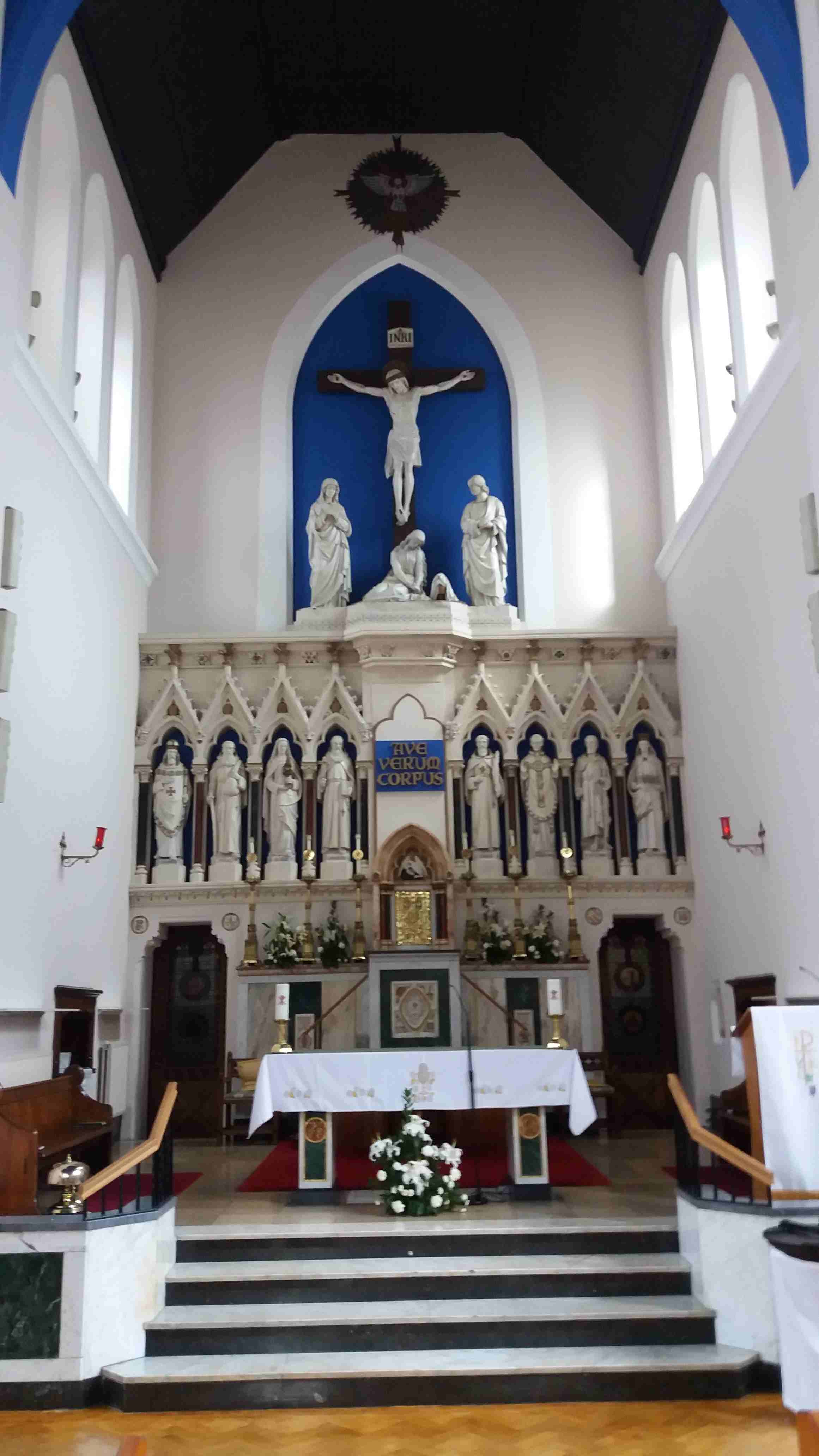
13. The High Altar
To view the High Altar it is best to move to the centre of the church and take a few steps back down the central aisle. Look upwards first of all to the representation of the Holy Spirit as a dove on the end wall.
The eye then travels down to the large Calvary scene depicting the crucified Christ with his mother Mary, John the beloved disciple, and Mary Magdalen. It is very similar to the one at the summit of the outdoor Way of the Cross at Pantasaph.
Below this scene are statues depicting eight Franciscan saints. Between them they represent all the branches which make up the Franciscan family: friars (the First Order), enclosed nuns (the Second Order or Poor Clares), and what used to be called the Third Order of St Francis, now divided into the Third Order Regular (unenclosed sisters or brothers living in community under vows) and the Secular Franciscan Order (men and women (often married) living and working in the world while maintaining their commitment to a Franciscan lifestyle).
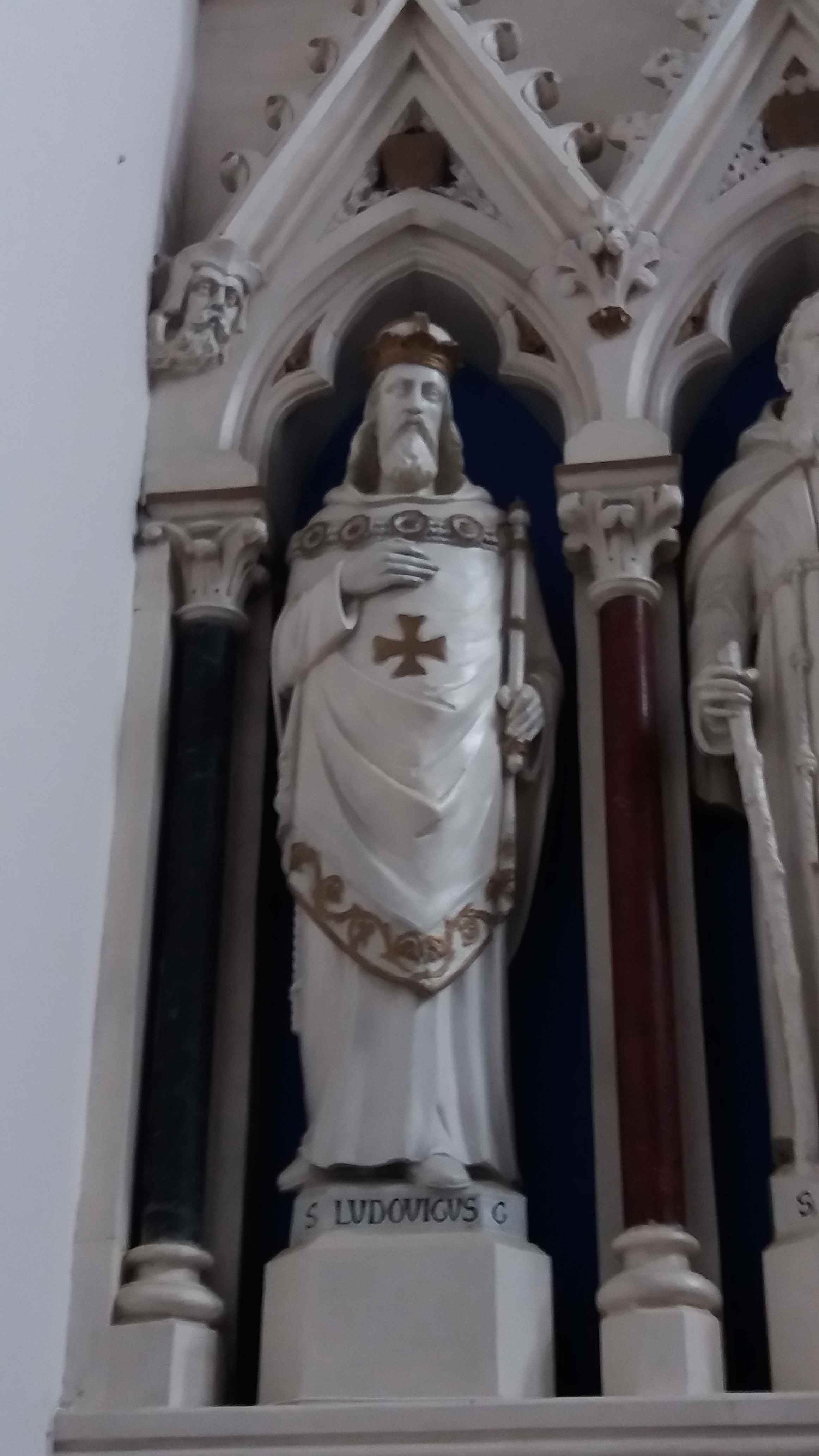
Starting from the left, the first is St Louis. Louis IX (1214-70), King of France, a man of austere and prayerful life with a passion for justice for the people of his kingdom, died of dysentery at Tunis while on Crusade. A member of what is now the Secular Franciscan Order, he is one of its patron saints. He is dressed as a mediaeval king, but if you look closely you can see a cord, like that worn by Franciscan friars round their waist, hanging down under his robes. Secular Franciscans used to wear such a cord, and two small pieces of habit-cloth joined by tapes over their shoulders, under their everyday clothes until after the Second Vatican Council.
More information from the Wikipedia Website Saint Louis
St Felix of Cantalice (1515-87) was a Capuchin lay brother who for forty years begged for food for his community in the streets of Rome. He used his duties as a chance to bring Christ to those whom he encountered and to try to make peace whenever he came across people in dispute. His tramping the city streets begging is indicated by his staff and the wallet he carries over his shoulder.
More information from the Wikipedia Website Saint FelixSt Clare of Assisi (1194-1253) was the daughter of a nobleman. When she was 18 she heard St Francis preaching and was captivated. What she really wanted to do was to live the same sort of itinerant lifestyle as he did, but there was no possibility of women from her background doing so at that time. She became abbess of the first convent of Franciscan nuns, and was known for her resistance (even in the face of the pope) to any attempt to ease the vow of absolute poverty which she and the other sisters had taken, and which she regarded as a privilege, not a burden. She is shown holding a monstrance, the container in which the consecrated host is exposed for adoration. According to legend, her convent was once threatened by a band of Moorish mercenary troops. Clare walked out carrying the monstrance containing the sacred host and they were immediately put to flight. She was declared a saint only two years after her death.
More information from the Wikipedia Website Saint ClareSt Laurence of Brindisi (1559-1619) was one of the most powerful preachers among the early Capuchins. He is one of the patron saints of the English province of the Order, and is shown with the conventional preacher's attributes of cross and Bible.
More information from the Wikipedia Website Saint LaurenceSt Fidelis of Sigmaringen was born Mark Rey in the town of that name in Prussia in 1577. He was a successful lawyer, but became disillusioned and entered the Capuchins. Another energetic preacher, he was on a preaching tour in Switzerland when he was attacked and killed by a Calvinist mob in 1622. As a preacher, he is shown holding a small cross; the palm branch indicates his martyrdom.
More information from the Wikipedia Website Saint FidelisSt Pacificus of Severino (1653-1721) was a member of the Observant branch of the Franciscan friars who was declared a saint in 1839. At the age of 35 he lost both his sight and his hearing, and also became crippled. He is shown here in his priestly vestments, which must be an allusion to Fr Pacificus, who was parish priest when the church was opened.
More information from the Wikipedia Website Saint PacificusSt Benedict Joseph Labre (1748-83) was an apparent misfit who tried his calling with several religious orders but was always rejected. He became both a pilgrim and a tramp who devoted himself to visiting shrines all over western Europe, begging his bread and sleeping rough. If anyone gave him money, he gave it away again. He spent the last few years of his life in Rome, where people began to regard him as a saint, which he was formally declared to be in 1881. He is portrayed with a pilgrim's staff and with his hand outstretched to beg. You can see the cord of a Secular Franciscan round his waist.
More information from the Wikipedia Website Saint BenedictSt Elizabeth of Hungary (1207-31), the daughter of that country's king, was married in 1221 to Louis IV, the Landgrave of Thuringia, in a political match. She was unsparing in her charity to the poor, apparently to her husband's annoyance and certainly to that of his brother, who drove her from the court after Louis' death in 1227, saying that her charities were too great a drain on the state finances. She settled in Marburg and at some point joined what is now the Secular Franciscan Order, whose cord can be seen beneath her robes. In art, she is generally shown carrying a basket of roses. Legend has it that she was once going out with a basket of food under her cloak to distribute to the poor. Her husband stopped her and asked what she had in the basket. Elizabeth said the first thing that came into her head: "Roses". Her husband pulled back her cloak, and there was the basket filled with roses. She was declared a saint in 1235 and is the other patron of the Secular Franciscan Order.
More information from the Wikipedia Website Saint ElizabethBelow is The Tabernacle, where the Blessed Sacrament is reserved. Above the doors to it you will see an image of a pelican feeding its young with its blood. This is a traditional symbol of Christ feeding us in the Eucharist. The six tall candlesticks which flank it were part of the initial furnishings of the church when it opened, as was the Paschal candlestick. The altar itself has of course been moved forward from the rear wall in accordance with the decisions of the Second Vatican Council in the I960's. The two ambos (lecterns) date from that time. The two doors at each side of the rear wall, however, date from the building of the church and contain attractive painted glass panels depicting incidents in the life of St Anthony of Padua. Both open into the friars' choir or private chapel where the friars recite their daily office of psalms; that on the left leads thence into the parish hall and the friary and that on the right into the sacristy.
14. Sacred Heart of Jesus
Before moving on, the two large statues, either side of the steps leading to the altar are worthy of note. On the left is a statue depicting the Sacred Heart of Jesus, a representation of the love of Christ, devotion to which, although it first appeared explicitly in the late 13th century, only became widespread after the Napoleonic Wars. It was declared a universal feast of the Church in 1856, and in 1875, the year our church was opened, Pope Pius IX exhorted all Catholics to consecrate themselves to the Sacred Heart. It might be considered a visual portrayal of the same sense of Jesus's overflowing love for mankind as is conveyed in the words of Methodist hymns dating from the same era.
15. Mary Holding the Child Jesus
On the right is Mary holding the child Jesus. The three sets of Latin words (one over each statue and one over the tabernacle) are all the opening words of Latin hymns or anthems: Cor Iesu (Heart of Jesus); Ave Verum Corpus (Hail, True Body) and Ave Maria (Hail, Mary).
16. Statues of St Augustine and St Patrick
High up near the top of the wall on either side are statues representing St Augustine and St Patrick, the apostles of England and Ireland respectively. Apart from forming a nice link between the two major originating elements in the congregation, they are tokens of gratitude to the parishioners of two Liverpool churches, St Augustine's and St Patrick's, both of which contributed most generously to the cost of building St Francis's.
17. The Front Benches
The kneelers in front of the first bench on either side of the aisle were made from the former altar rails after their removal as part of the re-ordering of the church following the Second Vatican Council. The original rails, like some of the other woodwork in the church including the block floor, were the work of a Capuchin lay brother and are beautifully carved. When the rails were removed it was decided to preserve them in this form as a memorial to all the lay brothers whose contribution to the life of the parish over the years has been so important. Similar reorderings in the church included the removal of the stone pulpit and the hanging sanctuary lamp, which have been replaced by electronic sound and lighting systems.
18. Chapel of St Joseph
Moving right, we come to the Chapel of St Joseph, which is also a memorial chapel commemorating the deceased members of the Hostage and Bordessa families, great benefactors to the church in its early years. Their names appear on mural tablets at the sides.
19. View of the Pipe Organ
This is a suitable point to turn towards the back of the church for a view of the recently rebuilt pipe organ in the gallery. It was built by Gray and Davison of Birmingham and originally installed in 1895, apparently replacing an earlier harmonium. It is a fine small instrument in regular use at Sunday masses and also for concerts and recitals.
20. Chapel of St Francis
Next is the Chapel of St Francis, which serves also as a memorial to another family of benefactors, the Tatlocks. It was a bequest from Canon Tatlock which paid off the debt on the church and cleared the way for it to be consecrated; the altar was erected in time for the consecration ceremony on 30 May 1900. The upper statuary depicts St Francis embracing the crucified Christ, a symbol of Francis's total devotion to his Master. The lower relief depicts St Francis during the last hours of his life on earth, towards sunset on 3 October 1226. He is lying, as he had requested, on the bare earth floor of the chapel of the Porziuncola (Little Portion) at Assisi. Originally he had asked for his habit to be removed, so that "naked he might lie upon the naked earth", but the Guardian of the friary personally gave him a habit, telling him that he should be aware that it was only lent to him, that he was ordered to wear it under obedience to his Guardian, and that he was forbidden to give it away. The friar holding the scroll is probably Brother Leo, the constant companion of St Francis who acted as his secretary, and whose "rolls and notes" furnished the material for the early “official” biographies of the saint written by Brother Thomas of Celano and the other works by Leo himself and other friars like Angelo and Rufino who had known Francis more intimately in his lifetime. St Francis died soon after sunset, his passing from this life to the next marked by the remarkable spectacle of a flock of larks flying in the darkness. Every year, on 3rd October, the ceremony of the Transitus, or Passing of our holy father St Francis, is celebrated in the church around sunset.
21. Shrine of St John Plessington
Proceed past the confessional to the shrine of St John Plessington. He was born near Garstang in Lancashire, educated at St Omer in northern France (it was illegal to conduct a Catholic school in this country at that time) and trained for the priesthood at Valladolid in Spain. He was ordained in Segovia Cathedral in 1663. After returning to this country he served first at Holywell in North Wales, which retained a continuous Catholic presence after the Reformation, and then from 1670 as chaplain to the Massey family at Puddington in the Wirral peninsula. Officially their children's tutor, he also operated a mission based on the chapel at Puddington Hall. During the anti-Catholic agitation at the time of the alleged "Popish Plot" he was arrested, imprisoned in Chester Castle, tried and condemned to death for his priesthood. On 19th July 1679 he was dragged on a hurdle from the Castle to Barrelwell Hill, Boughton, the place of execution for criminals. There he was hanged, drawn and quartered. On 19th July 1979 the third centenary of his martyrdom was marked by a procession of several thousand people from Boughton to the Castle Square, where Pontifical High Mass was celebrated by the Apostolic Delegate to Great Britain, Archbishop Bruno Heim. For the Mass, Archbishop Heim wore a set of vestments which had once belonged to John Plessington. The present statue replaces the earlier wooden one of that time. St Francis's has a relic of the saint which is venerated each year on 19th July.
22. Portraits of Saint Pio of Pietrelcina and Blessed Leopold Mandic
Above the confessional which you have just passed, and above the one to the right of St John Plessington's shrine, hang portraits of two Capuchin friars, both priests, whose holiness of life has been officially recognised by the Church in recent years. That their portraits hang above the confessionals is appropriate because each of them made helping people through the administration of the Sacrament of Reconciliation a major part of his ministry. Saint Pio of Pietrelcina, on the left, was famous Italian friar who ministered in the confessional but is better known (under the name of Padre Pio which he bore in his lifetime) because he bore in his body the marks of Christ's crucifixion. Whatever one makes of this phenomenon generally, its authenticity is beyond doubt in this case, though it is worth remembering that no-one has ever been declared Blessed, or a saint, simply because he or she bore the stigmata. On the right is Blessed Leopold Mandic, born in 1866 at Herçeg-Novi in Croatia. He died in 1942 at Padua, having spent the greater part of his priestly life hearing confessions. This role was not one that he found naturally appealing, but he persevered and won renown locally and further afield as a confessor. He offered his labours as a sacrifice to God for the reunion of Catholic and Orthodox Christians. He must have been only too aware of the tensions existing in his native land, and which surfaced after the break-up of the former Yugoslavia, with such tragic consequences for its people.
23. Plaque Commemorating the Rev Ralph Platt
Continuing, just before you return to the back of the church, you will see a small plaque in the corner. This commemorates the Rev Ralph Platt. He was the last of John Plessington's successors as chaplain to the Massey family of Puddington, dying in 1837. Towards the end of his ministry he came to realise that the system of missions based on the country houses of local Catholic gentry, vital in penal times, was no longer appropriate to his own day, and on his death he left his life’s savings towards the building of an independent chapel at Neston, the nearest town. This was opened in 1843, and was the basis of the present church of St Winefride, which still contains St John Plessington's chasuble.
24. The Repository
In the corner of the church is the repository, where devotional books and articles may be bought. It was originally the baptistery, until the font was moved to its present location in the body of the church in line with the practices recommended subsequent to the Second Vatican Council. The wooden cupboard set into the far wall was designed to hold the holy oils.
25. The Stations of the Cross
In your progress round the church you will have passed at intervals the Stations of the Cross, fourteen representations of incidents on Christ's route from Pilate's judgement hall to the tomb. This devotion, like the Christmas crib, grew up under Franciscan influence during and after the Crusades when the Holy Places in Jerusalem were under Muslim control and inaccessible to Christians. Since the end of the 18th century their presence has been required in all Catholic churches as an aid to meditation on Christ's suffering for mankind.
Having completed your tour of the church, and seen its memorials and its representations of Franciscan and other saints, you may care to reflect for a moment on the words of the writer of the Letter to the Hebrews:
'Remember your leaders, those who spoke the word of God to you; consider the outcome of their way of life, and imitate their faith. Jesus Christ is the same yesterday and today and forever.' (Heb. 13: 7-8, NRSV)

